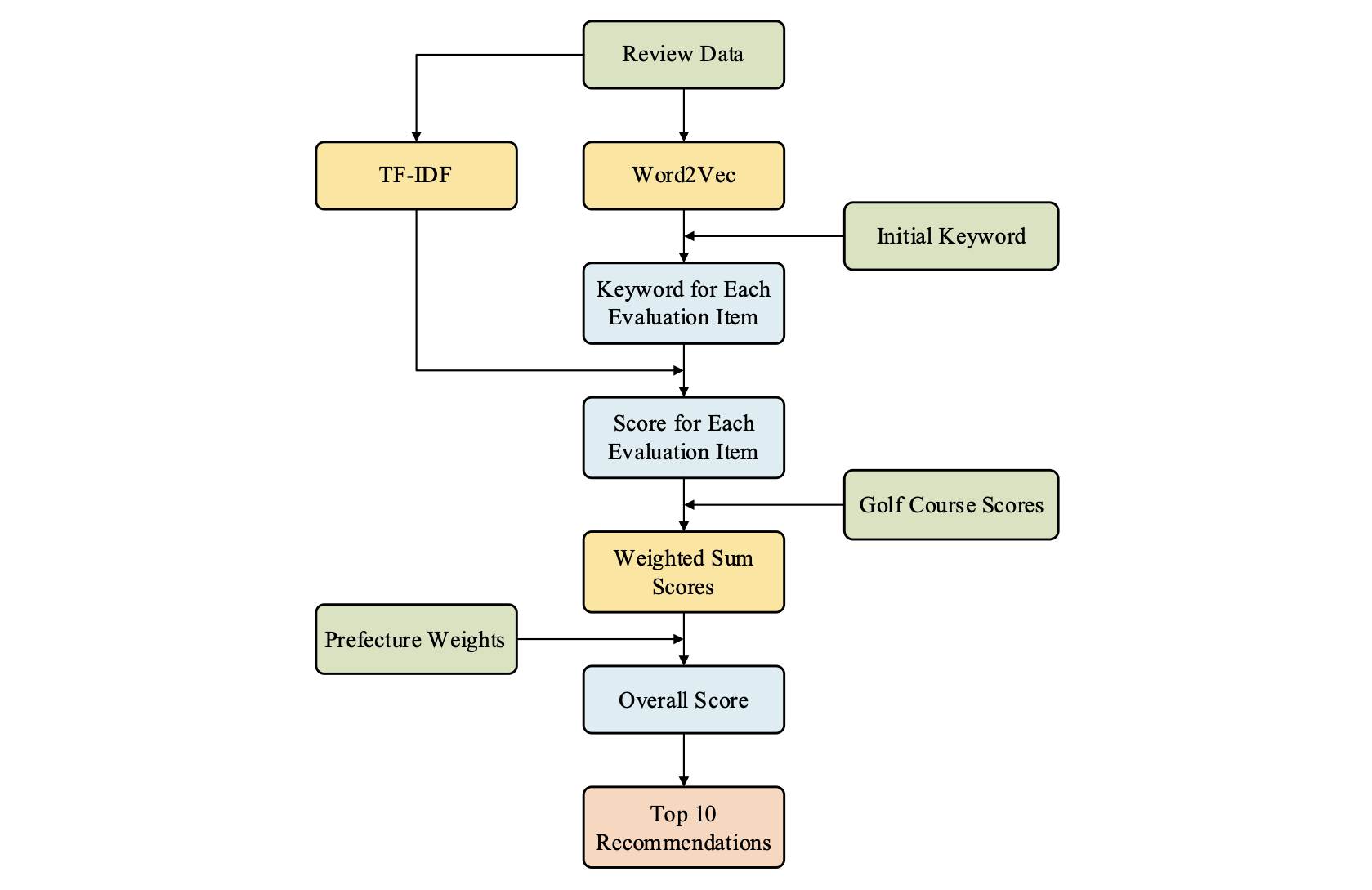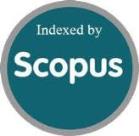Effective Recommendation Considering Customers’ Needs Using Review Texts with TF-IDF and Word2Vec: Case of Golf Course
DOI:
https://doi.org/10.46604/aiti.2024.14699Keywords:
recommendation, golf course, Word2Vec, TF-IDFAbstract
This paper aims to recommend the most suitable golf course for each user by focusing on golf courses and analyzing customer reviews. Furthermore, by examining the recommendation results, the goal is to clarify the characteristics of each golf course from the user’s perspective and contribute to the promotion of each golf course. The procedure of this paper is first to extract user preferences using Word2vec and TF-IDF from reviews. Next, the extracted user preferences are matched with golf course features. Finally, recommendations are made based on the geographical relationship between the user and the golf course. As a result, a high accuracy rate is achieved. Additionally, some keywords that should be used in promotions for each golf course feature have been identified.
References
Ministry of Internal Affairs and Communications, “2016 Information and Communications White Paper,” https://www.ituaj.jp/wp-content/uploads/2016/10/nb28-4_web-07-Report-Overview2016WhitePaper.pdf, 2016.
Ministry of Economy, Trade and Industry, “Long-Term Data,” https://www.meti.go.jp/statistics/tyo/tokusabido/result/result_1.html, 2024.
M.A.H. Bekken, P.D. Mitchell, and D.J. Soldat, “An Eco-Efficiency Model for Golf,” Ecological Indicators, vol. 166, article no. 112357, 2024.
Y. Izumi, H. Shigeoka, and M. Yagasaki, “Golfing CEOs,” Labour Economics, vol. 91, article no. 102639, 2024.
N. Edwards, C. Dickin, & H. Wang, “Low Back Pain and Golf: A Review of Biomechanical Risk Factors,” Sports Medicine and Health Science, vol. 2, no. 1, pp. 10-18, 2020.
M. Khazaeli, ' L. Javadpour, “Golf Club Selection with AI-Based Game Planning,” Entropy, vol. 26, no. 9, article no. 800, 2024.
H. Morise, K. Atarashi, S. Oyama, and M. Kurihara, “Neural Collaborative Filtering with Multicriteria Evaluation Data,” Applied Soft Computing, vol. 119, article no. 108548, 2022.
E. Asani, H. Vahdat-Nejad, and J. Sadri, “Restaurant Recommender System Based on Sentiment Analysis,” Machine Learning with Applications, vol. 6, article no. 100114, 2021.
M. Elahi, D. K. Kholgh, M. S. Kiarostami, M. Oussalah, and S. Saghari, “Hybrid Recommendation by Incorporating the Sentiment of Product Reviews,” Information Sciences, vol. 625, pp. 738-756, 2023.
Z. Abbasi-Moud, H. Vahdat-Nejad, and J. Sadri, “Tourism Recommendation System Based on Semantic Clustering and Sentiment Analysis,” Expert Systems with Applications, vol. 167, article no. 114324, 2021.
I. Syafganti, and M. Walrave, “Assessing the Effects of Valence and Reviewers’ Expertise on Consumers’ Intention to Book and Recommend a Hotel,” International Journal of Hospitality & Tourism Administration, vol. 23, no. 5, pp. 904-923, 2022.
X. Wang, J. Zheng, L. Tang, and Y. Luo, “Recommend or Not? The Influence of Emotions on Passengers' Intention of Airline Recommendation during COVID-19,” Tourism Management, vol. 95, article no. 104675, 2023.
J. Zhou, Z. Ye, S. Zhang, Z. Geng, N. Han, and T. Yang, “Investigating Response Behavior through TF-IDF and Word2Vec Text Analysis: A Case Study of PISA 2012 Problem-Solving Process Data,” Heliyon, vol. 10, no. 16, article no. e35945, 2024.
Z. Zhang, F. Han, H. Zhang, T. Aoki, and K. Ogasawara, “Examining the Effect of the Ratio of Biomedical Domain to General Domain Data in Corpus in Biomedical Literature Mining,” Applied Sciences, vol. 12, no. 1, article no. 154, 2022.
A. Al Tawil, L. Almazaydeh, D. Qawasmeh, B. Qawasmeh, M. Alshinwan, and K. Elleithy, “Comparative Analysis of Machine Learning Algorithms for Email Phishing Detection Using TF-IDF, Word2Vec, and BERT,” Computers, Materials and Continua, vol. 81, no. 2, pp. 3395-3412, 2024.
A. Liyih, S. Anagaw, M. Yibeyin, and Y. Tehone, “Sentiment Analysis of the Hamas-Israel War on YouTube Comments Using Deep Learning,” Scientific Reports, vol. 14, no. 1, article no. 13647, 2024.
M. A. Abid, M. F. Mushtaq, U. Akram, M. A. Abbasi, and F. Rustam, “Comparative Analysis of TF-IDF and Loglikelihood Method for Keywords Extraction of Twitter Data,” Mehran University Research Journal of Engineering and Technology, vol. 42, no. 1, pp. 88-94, 2023.
Rakuten Group, Inc., “Rakuten GORA Data,” https://dsc.repo.nii.ac.jp/?action=pages_view_main&active_action=repository_view_main_item_detail&item_id=1754&item_no=1&page_id=13&block_id=21, 2010.
C. D. Manning, P. Raghavan, and H. Schütze, Introduction to Information Retrieval, Cambridge University Press, 2008.
A. Subbiah, and V. Aggarw, “Transformers in Music Recommendation”, https://research.google/blog/transformers-in-music-recommendation/, 2024.
G. de Souza Pereira Moreira, S. Rabhi, J. M. Lee, R. Ak, and E. Oldridge, “Transformers4Rec: Bridging the Gap between NLP and Sequential / Session-Based Recommendation,” Proceedings of the 15th ACM Conference on Recommender Systems (RecSys’21), pp. 143-153, 2021.
M. Traub, D. Kowald, E. Lacic, P. Schoen, G. Supp, and E. Lex, “Smart Booking without Looking: Providing Hotel Recommendations in the TripRebel Portal,” Proceedings of the 15th International Conference on Knowledge Technologies and Data-driven Business, article no. 50, pp. 1-4, 2015.

Published
How to Cite
Issue
Section
License
Copyright (c) 2025 Kodai Kimura, Takashi Namatame

This work is licensed under a Creative Commons Attribution-NonCommercial 4.0 International License.
Submission of a manuscript implies: that the work described has not been published before that it is not under consideration for publication elsewhere; that if and when the manuscript is accepted for publication. Authors can retain copyright in their articles with no restrictions. is accepted for publication. Authors can retain copyright of their article with no restrictions.
Since Jan. 01, 2019, AITI will publish new articles with Creative Commons Attribution Non-Commercial License, under The Creative Commons Attribution Non-Commercial 4.0 International (CC BY-NC 4.0) License.
The Creative Commons Attribution Non-Commercial (CC-BY-NC) License permits use, distribution and reproduction in any medium, provided the original work is properly cited and is not used for commercial purposes.







